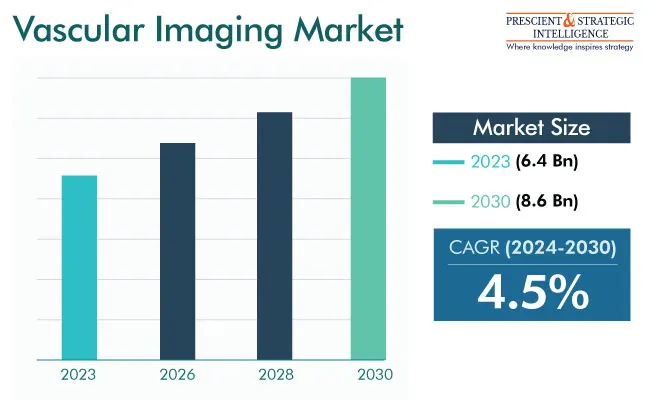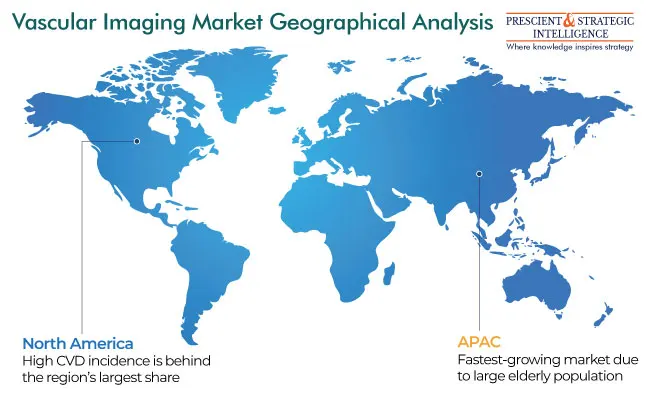Report Code: 10884 | Available Format: Excel
Vascular Imaging Market Research Report - Global Size, Share, Growth Drivers, Regional Outlook, Development and Forecasts, 2024-2030
- Report Code: 10884
- Available Format: Excel
- Report Description
- Table of Contents
- Request Free Sample
Vascular Imaging Market Overview
The vascular imaging systems market is expected to advance from USD 6.4 Billion (E) in 2023 to USD 8.6 Billion in 2030, at 4.5% CAGR between 2024 and 2030.
- According to the World Heart Federation, the number of individuals who died from cardiovascular conditions was 20.5 million in 2021, accounting for approximately 1/3 of all deaths globally.
This is because of the rising incidence of CVDs, surging elderly populace, technological improvements, and increasing healthcare spending.

Driver
- Rising Incidence of Cardiovascular Diseases: Cardiovascular diseases are the major causes of death across the globe. Moreover, its incidence is likely to surge because of inactive lifestyles, increasing obesity rates, and an aging populace. The rising need for diagnosis, as well as treatment of vascular disorders, boosts the demand for proper imaging systems.
- According to the CDC, in 2021, approximately 695,000 individuals died due to heart disease in the U.S., which is 1 in every 5 deaths.
- Surging Elderly Population: The aging populace across the globe is driving the requirement for minimally invasive diagnostic and treatment measures, boosting the acceptance of vascular imaging systems.
- According to the UN, there will be 1.6 billion individuals who are 65 years/older globally in 2050. Moreover, the number of individuals who are 80 years/older is increasing even quicker.
- Technological Improvements: Constant improvements in imaging technologies such as hybrid imaging systems, miniaturization, and AI-driven image analysis are resulting in quicker procedures, decreased invasiveness, and greater accuracy. This attracts both medical professionals and patients.
- Increasing Healthcare Spending: Healthcare spending has increased across the globe, mainly in developing nations. This is offering more openings for investment in cutting-edge medical technologies, including vascular imaging systems.
- As per the WHO, the global expenditure on health touched a new high of USD 9.8 trillion in 2021.
Innovations in Tailored Diagnosis & Remote Consultations Is Key Trend
The healthcare landscape is observing a significant move towards non-invasive as well as low-dose imaging methods. The focus on reducing patient worry and decreasing radiation exposure has led to a higher acceptance of ultrasound & low-dose CT systems. This development shows a commitment to improving the overall patient experience while sustaining diagnostic precision.
- For example, the requirement for radiation dose management globally will reach a value of USD 973.2 million in 2030.
Moreover, the incorporation of ML and AI is changing the realm of medical imaging. AI-enabled tools are playing an important role in enhancing diagnosis, image analysis, and workflow effectiveness, thus offering medical providers greater abilities for tailored treatment selections. Furthermore, the advent of telemedicine is driving the requirement for cloud-based and portable imaging systems, enabling remote sessions as well as diagnostics. Such technological improvements underline the dynamic nature of healthcare, where modernization meets with an emphasis on patient-centric methods.
- For instance, the global demand for AI-based medical imaging will reach a value of USD 11,921.4 million in 2030.
- Likewise, the demand for telemedicine will reach USD 144.2 billion by the end of this decade.
Challenge
- Shortage of Skilled Workforces: While advanced imaging machines are highly required, a very qualified workforce is another thing that needs to be taken care of because the current state of expertise doesn’t meet the demands. This lack not only hinders the effective operation of the devices but also affects the growth potential of this industry.
- The World Health Organization estimates an expected shortage of 10 million health workers by 2030, particularly in low- and lower-middle-income nations.
- Moreover, according to a survey by the American Society of Radiologic Technologists, in the U.S., the vacancy rate for medical imaging professionals is 18.1% in 2023, which is an all-time high and a rise from 6.2% in 2021.
- High Equipment & Maintenance Costs: The major challenge for small healthcare facilities comes from the large initial expenses for developed imaging systems. Furthermore, the added expenses associated with maintenance are adding to the financial obstacles.
- Regulatory Compliance: The healthcare sector must deal with complex regulatory frameworks regarding imaging equipment as well as data privacy. This complication led to a major challenge for both medical providers and manufacturers, demanding them to navigate as well as comply with evolving regulations & standards.
| Report Attribute | Details |
Market Size in 2023 |
USD 6.4 Billion (E) |
Revenue Forecast in 2030 |
USD 8.6 Billion |
Growth Rate |
4.5% CAGR |
Historical Years |
2017-2023 |
Forecast Years |
2024-2030 |
Report Scope |
Market Trends, Drivers, and Restraints; Revenue Estimation and Forecast; Segmentation Analysis; Impact of COVID-19; Companies’ Strategic Developments; Market Share Analysis of Key Players; Company Profiling |
Explore more about this report - Request free sample
Hospitals Are Largest End User
The hospitals category, based on end user, is the largest contributor to the industry. This is because of the monetary resources for buying advanced equipment, strong competition among healthcare providers, and enormous patient pools in these settings. Moreover, the demand for vascular imaging equipment in emergency wards will surge because of the increasing hospital emergency admissions for diseases such as stroke, abdominal discomfort, and chest pain.
According to the U.S. CDC:
- Someone in the U.S. has a stroke every 40 seconds.
- Someone dies of a stroke every 3 minutes & 14 seconds.
- Over 795,000 individuals in the U.S. have a stroke every year.
- Around 610,000 of these numbers are 1st or new strokes.
To avoid complications, such a condition requires a quick and precise diagnosis. Therefore, the requirement for portable as well as rapid imaging devices will rise during this decade.
MRI Accounts Largest Share
The MRI category, based on product, accounts for the dominating share of the industry. This can be ascribed to the better soft tissue contrast as well as multiplanar imaging abilities offered by this product. For accurate diagnosis as well as treatment planning in vascular imaging, the capacity to observe blood vessels with high detail and clarity is important. The imagining of tiny veins and finding of modest vascular irregularities are made possible by MRI's greater spatial & contrast resolution. Medical experts, with the utilization of this skill, can accurately evaluate vascular structure, detect occlusions or stenosis, and measure the seriousness of vascular disorders.
North America Is Dominating Market
North America is the largest contributor to the industry. The regional industry's largest share can be ascribed to the surging incidence of cardiovascular diseases in this continent. The incidence of cardiovascular disorders, mainly valvar heart conditions including mitral regurgitation and aortic stenosis, is relatively high in this region. Moreover, the surging prevalence of such disorders is because of the sedentary lifestyles, rising elderly population, and incidence of risk factors including hypertension and obesity.
- In Canada, heart disease was the 2nd main cause of death in 2021, accounting for 17.7% of all deaths in 2021.
- Moreover, in the U.S., mitral regurgitation is the most common valvular lesion, and more than 2.5 million individuals are likely to have moderate‐to‐severe mitral regurgitation, and this number will double in 2030.
APAC is likely to advance at a significant CAGR during this decade. The growth in this region can be ascribed to the increasing incidence of obesity, diabetes, and CVDs. Moreover, such conditions arise mainly due to behaviors such as smoking, drinking alcohol, sedentary lifestyles, and improper diet.

- As per the World Obesity Atlas 2023, the incidence of obesity among adolescents and children in the Southeast Asian Region is likely to increase significantly during 2020–2035, from 5%–16% of boys, and from 3%–11% of girls.
- Likewise, the incidence levels for adults are likely to double during the same period, from 8%–16% of women, and from 4%–10% of men.
Competitive Landscape
The vascular imaging systems market is dynamic as well as competitive. Staying ahead necessitates constant innovation, strategic partnerships, and an emphasis on addressing changing consumer requirements & market trends.
- In July 2022: the ARTIS icono ceiling angiography system attained approval from the U.S. FDA for its utilization across different advanced & routine measures in interventional radiology & cardiology. Siemens Healthineers introduced the ARTIS icono angiography system in September 2022 in India.
- In November 2020: GE Healthcare declared the acquisition of Prismatic Sensors AB, a Swedish startup focusing in photon counting detectors. This acquisition underscores GE Healthcare continued investment in photon counting CT, a technology with the potential to revolutionize medical imaging.
Major Players in the Industry Are:
- General Electric Company
- Siemens AG
- Hitachi Ltd.
- Carestream Health Inc.
- Koninklijke Philips N.V.
- Hologic Inc.
- Shimadzu Corporation
- Esaote S.P.A
- Canon Inc.
- Fujifilm Holdings Corporation
- Orthoscan Inc.
- Abbott
- Samsung Group
Want a report tailored exactly to your business strategy?
Request CustomizationWant an insight-rich discussion with the report author?
Speak to AnalystOur dedication to providing the most-accurate market information has earned us verification by Dun & Bradstreet (D&B). We strive for quality checking of the highest level to enable data-driven decision making for you
Our insights into the minutest levels of the markets, including the latest trends and competitive landscape, give you all the answers you need to take your business to new heights
With 24/7 research support, we ensure that the wheels of your business never stop turning. Don’t let time stand in your way. Get all your queries answered with a simple phone call or email, as and when required
We take a cautious approach to protecting your personal and confidential information. Trust is the strongest bond that connects us and our clients, and trust we build by complying with all international and domestic data protection and privacy laws